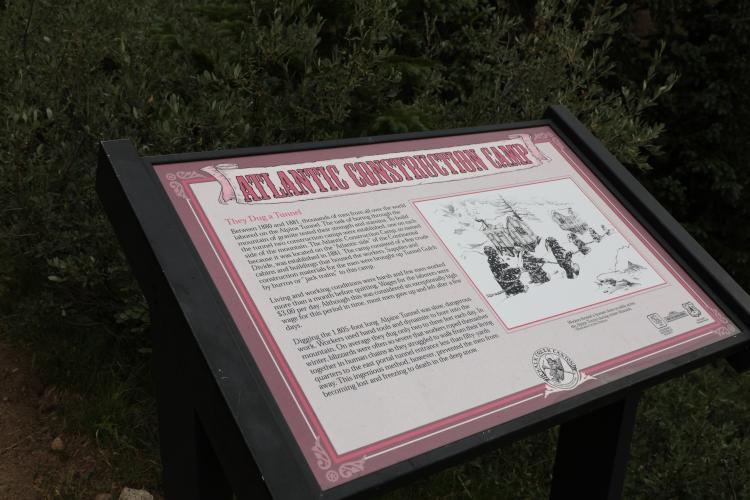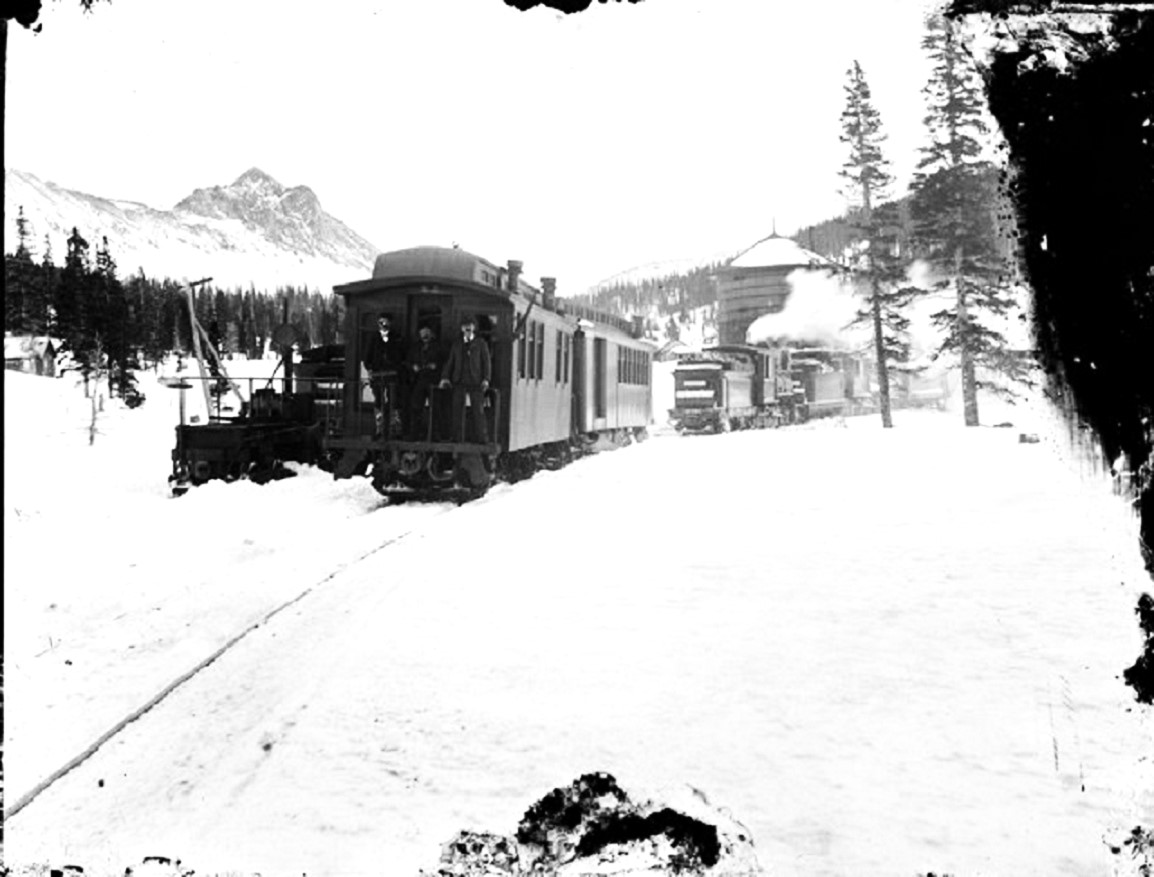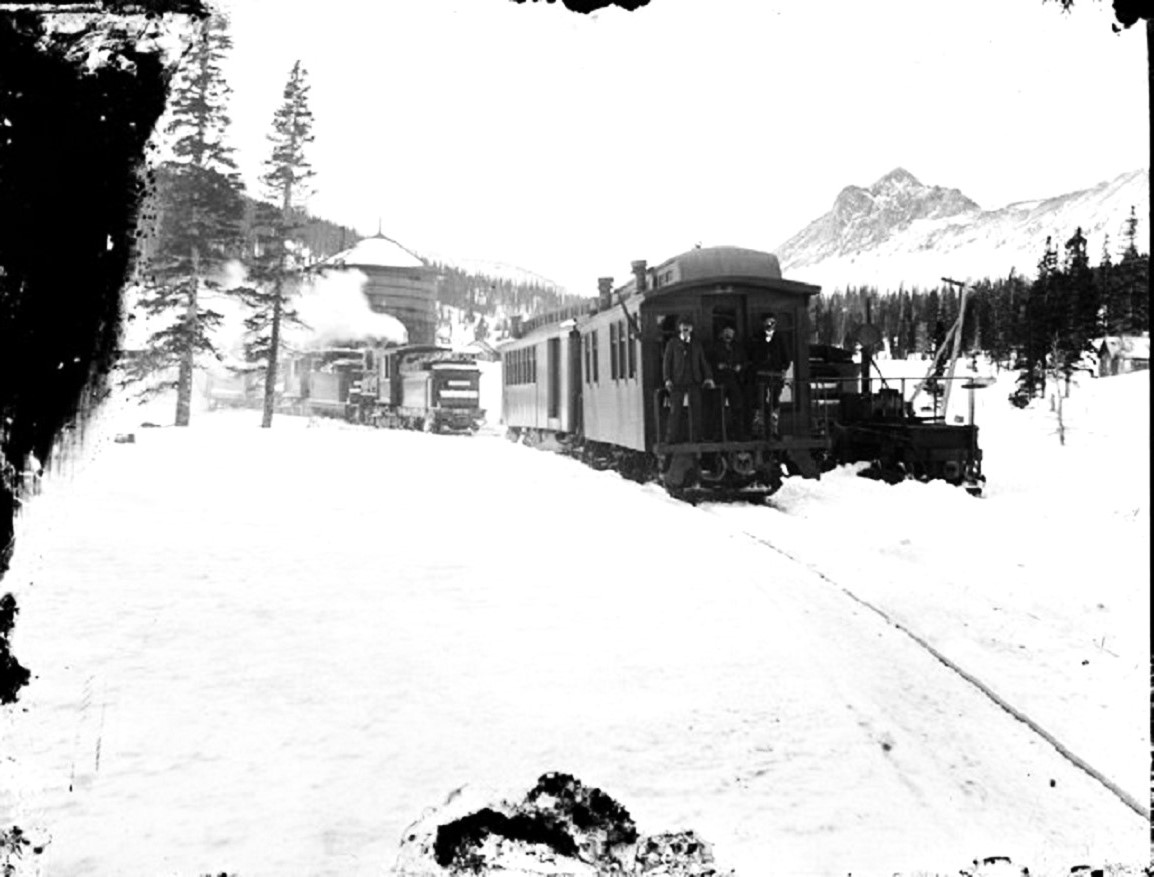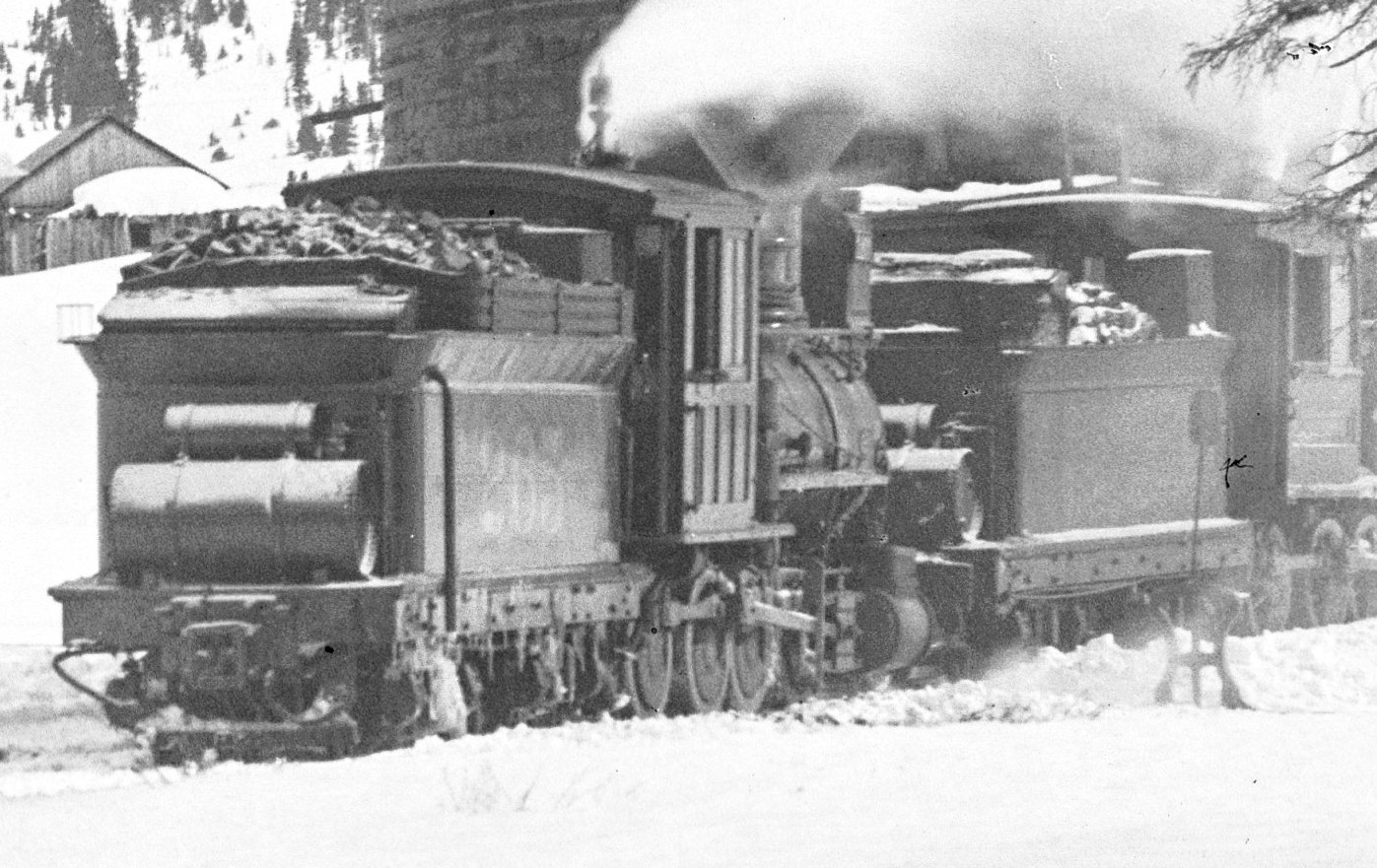Alpine Tunnel Construction Camps
Alpine Tunnel Construction Camps
|
I was recently re-reading parts of Dow Helmer's Historic Alpine Tunnel book particularly about his discovery of the construction camp sites. Having fixated on the railroad's operating days I hadn't given the question of "How did they get all the construction material up to such a high-altitude remote location?" much thought. Consider hauling up all those redwood timbers? This would take a serious road and one that was not the right-of-way so as not to impede grading and track construction.
In my last visit to the east portal I noticed a sign a bit off the right-of-way pointing to one of the construction camps. I took a few photos which I have put on a blog post here. I wish I had re-read Helmer's discovery before visiting as I could have explored the area more. There were two other construction camp sites. One is roughly on the opposite side of the valley known as Tunnel Gulch (not to be confused with the same name on the western side). The other is near the west portal on the hillside to the right of the right of way. Does anyone have any photos of these two sites? Enjoy, Kurt 
|
Re: Alpine Tunnel Construction Camps
|
Hi Kurt,
From what I've read. During the construction of the tunnel, the tracks were extended up to the Atlantic construction camp. There was a siding there at Atlantic, listed as MP 161.0 and having a 489' siding according to Helmers timetable reprint in the Historic Alpine Tunnel, 1st. edition, page 115. DL&G Timetable, 1898. The tunnel itself is listed as MP 161.8 If I were going to get material to build the tunnel, I would either shove or pull the material up from Hancock. Set it out and take the empty cars (Probably flats or Gondolas) back down to Hancock or Buena Vista, wherever the Work Train originated from and set them out for the first Denver-bound train, or to wherever the empties from the tunnel and loads from California or the closest redwood mill were received or transferred from Std. to 3' gauge in intechange Since there was only a siding at Atlantic, the locomotive would probably have to use either the Wye at Hancock (not listed in 1898 tt) or the turntable at St. Elmo (Shown in 1898). One caveat, the wye not listed at Hancock in this timetable shows clearly in a famous photo of a DL&G business car taken during the same time period. Rick |
Re: Alpine Tunnel Construction Camps
|
This post was updated on .
Rick, great information. A few items and a question.
Atlantic is not listed on the Oct. 1st, 1884 Employee Timetable but is listed in the 1889 timetable reprinted in the endleaves of Mac Poor's DSP&P. Not definitive documents on its existence but you could be led to believe Atlantic siding wasn't built until the mid- to late-1880s. Or you could be led to believe it was built during 1881--whether left or removed in 1882 or 1883, we don't know. I do think it is plausible the company didn't see a siding as critical for unloading on a dead-end construction stub. St Elmo got the turntable in July 1885 both in anticipation of Aspen traffic and the newly discovered need for months-long winter closures of the line from St Elmo or Hancock and Pitkin. An interesting side comment in one newspaper is that with the turntable the trains will no longer have to back down Chalk Creek Canyon during tunnel closures. Backing was a tolerated norm for a period of time, which I hadn't expected. I need some clarification on that Hancock photo. Is it the one in Helmer's book on page 123 with the flangers, business car and passenger car? And is the wye indicated in it by the engines appearing to sit on the wrong side of the water tank? Or is it another photo? There IS another photo taken on the same day from the other side of the train that can be seen in Klinger's Gunnison book, I think page 152. Hancock's wye in the 19th century is a head-scratcher for me--it makes sense but there is conflicting information as to its existence. I've learned that what makes sense to me wasn't necessarily how railroaders thought in the 19th century. I know, welcome to the South Park. <slightly edited> The main reasons I've wondered if it existed at that time is based on no wye listed at Hancock in South Park/DL&G timetables I've seen (1884, 1889, 1898) and also on the C&S discussions starting in November 1903 about putting in a wye at Hancock, a discussion that implies there was no wye there, almost like there hadn't been one there for some time, if ever. It was approved and built. As much as logic suggests otherwise I can't overlook these items. And I agree with Jim Courtney's argument that a wye made sense during construction but I just haven't found anything to substantiate that. Could it have been put in during 1881 only to fall out of use in 1882 once full operation to Gunnison started? The DL&G era photo seems the one solid supporting piece of evidence for a pre-C&S wye I've found or heard of, I'm just not certain which photo clearly shows the wye at that time.
Dave Eggleston
Seattle, WA |
Re: Alpine Tunnel Construction Camps
|
Hi Dave,
Of course, you're correct in the timetables, etc. BUT, as you said, what is the point of using a track built for construction for something (or anything) else at that remote location. I don't know if any of what I am about to say pertains to what happened up there it is 100% conjecture. Back then Taxes were always a consideration and remember that the DSP&P/DL&G was owned by Big Daddy Uncle Pete for most of their lives. It wasn't until 1893, after the death of Jay Gould and the bankruptcy of UP that they came under the receivership of Frank Trumbull and began the long climb back. Thanks to Trumbull's coal holdings at Baldwin. But back to taxes. To not count a track as taxable, it has to be inaccessible to use. My thought (remember 100% conjecture) is that the Wye at Hancock was made "unusable" by removing the rail or spiking the switch and removing the switchstand or removing a piece of rail so that it could not be used. The same thing could pertain to Alpine. It could sit, much like the Morning Star siding on the Georgetown Loop, with no working turnouts. Why put it back into service? Perhaps the tunnel needed some repairs or work on the snowsheds or doors on the east end and the "station" was put back into service as a matter of convenience, having the accounting department list it as new. I saw this done on a couple of broad gauge short lines that I worked on. As for the wye? I see Ferrell lists it on his 1885 map of Hancock in his South Park book. Again, the C&S might have had to go in, replace some rotten ties, straighten some kinked rail and put new switchstands in place and voila! a new wye. Of course, unless there is a repair record of a Section Foreman for that district from 1883-1900, we will never know the absolute facts of the matter. As I said, this is just conjecture and nothing more, but it does provide a plausible explanation as to the gaps during the UP ownership years. Rick |
Re: Alpine Tunnel Construction Camps
|
This post was updated on .
I absolutely agree with you, Rick. This is heavily based on conjecture. And you make a fantastic point about taxation. We're on the same page. And yep, documentation is poor and even the C&S had no idea of quite a bit of the history of what it inherited. Even the DL&G didn't. All I have are two asks:
My first ask is to a source for that picture of the D&LG car sitting by the Hancock wye so I'm sure I'm looking at the same picture you mention. My second ask is for anything documenting/showing a wye in place prior to 1904. I agree that a wye there in 1881 is logical but also conjectural. Beyond that, I only know of a few pieces of evidence about a wye there at all: the DL&G era photo and later correspondence, ICC map and C&S timetables. Questioning the wye goes against a long-held belief. I believed it. Then my reading late 1903 correspondence in Daniel Edwards' Vol. 1 South Park Documentary History, pages 94-95 are several transcribed letters on building a wye at Hancock, ultimately AFE 118, dated 11/6/1903. Sept 30, 1903: a recommendation to "put in a Y at Hancock" to address the need for turning engines during winter, which would pay for itself in saved overtime and shoveling expenses incurred by engines backing between Hancock and the Tunnel. Nov 6, 1903: laying out expenses and a recommendation of location which will "take a small amount of work to make a wye." It includes 548 yards of grading and materials, for 1300' of track, including rail, frogs, spikes, switch stands, etc. Nov 9, 1903: more justification, primarily to handle snow removal issues between Hancock and the Tunnel. "The nearest wye east of the tunnel is located at Mt. Princeton [...] the nearest wye on the west side is located at Pitkin." [No mention of the turntable at the tunnel enginehouse--in place but unused?] Jan 14, 1904: covering extra expenses required, which included grading frozen earth, blasting several boulders and making the tail 16' longer to accomodate the rotary. Conclusive? Absolutely not, but this could be read like there was no wye in place at that time, in fact no rails nor grade. It could possibly be read as a large reworking of an existing grade. And we could make the conjecture that a wye was there and later removed and then forgotten by those working in Denver. The wording raises just enough question to catch my eye. Yes, it goes against the overwhelming historical belief . Perhaps sacrilegiously I've cautiously wondered if that belief of a wye at Hancock was a projection backward into time from a reference on a C&S document (timetable or ICC map?), an assumption, a logical idea, that became codified in Poor's opus and has been perpetuated in later books, such as Ferrell. Neither Poor nor Ferrell cite the source of their reference and map. I wish they had! Only that photo provides insight on a wye during the 1890s.
Dave Eggleston
Seattle, WA |
Re: Alpine Tunnel Construction Camps
|
This post was updated on .
Hi Dave,
In the book Across the Great Divide, the History of the Alpine Tunnel in Images. Page 67 shows "The DL&G three engine Passenger train at Han(d)cock Late 1890's. You cen see the business car at the end of the train, and a combine ahead of it, with a flanger set off to the side of the Business car with what looks like a Rotary or Locomotive tender ahead of the flanger. This is the same Photo shown in Ferrell on page 154. The same photo again in Helmers, 1963 first printing, Page 146 and again in Helmers, 1971 Printing on page 123. Tom Klinger shows the same photo on his South Park's Gunnison Division Memories and then some on page 151. Of course, there is the map published in Ferrell's The South Park Line, showing Hancock with a wye on the map dated 1885 on pg 84, drawn by Mal himself. The big problem with researching something like this is that you can tell that it was there, but you can't tell when they built it. I can show you grades all over Wyoming and Colorado, so you know that it was there, but there are no built dates... I have no access to any of the original construction or intermediate roadway drawings of the DSP&P or DL&G and I only have the NARA ICC valuation drawings of the C&S. I got mine before the CRRM published their half size folios. But thank goodness that they did. The copies of the ICC valuation maps, which are 24" in height and quite long are a pain to store anywhere. The issuing railroad kept the original black line maps and the ICC was given blueprints. The CRRM reversed the color and turned them back into black lines on white paper, instead of the reverse. In the 1893 receiver's report for DL&G during the UP bankruptcy, there is an interesting notation. it says "Atlantic. 489 ft." So we can say that it was definitively there at that time. However, in this Receiver's inventory, trackage and type are not listed, only the accrued sum of all the track in service, so nothing about a wye at Hancock. Another conjecture... What if the tail track on the Wye at Hancock was only long enough to turn one or two locomotives? If the C&S wanted to turn a rotary with the entire locomotive consist (several locomotives) on the wye. The wye, by necessity, would have to have the tail track lengthened as turning locomotives one at a time is an expensive pain in the tail and takes lots of time (time = $$$). The tail track would have to be lengthened and if the curve was too sharp for the Rotary to take, the curvature on each leg of the wye would have to be "Straightened out" to accomodate the Rotary. Thus the grading and clearing price. Reasoning: At that altitude and on that grade it could be dangerous to bust the air line of the locomotive consist just to turn the head end to get it heading the proper direction. Believe me that when you are up that high in the rarefied air, with winter cold and wind blowing, you are begging for troubles busting the air brake lines, anything from freezing up to a runaway. I speak from personal experience with compressed air in Wyoming blizzards. Of course, each locomotive would have had an Engineer and Fireman who would have been on the clock during the delay turning each locomotive separately. How could this be done at Alpine Tunnel on the other end of the Snow run? Think about the lack of grade beside the engine house, the engine house was heated and there were probably mechanical men on duty there to take care of things, as both freight and Passenger trains were asked to make a thorough brake inspection and to turn up the retainers and inspect the equipment before heading down to Hancock or down to Pitkin. The turntable in the Engine House should have been long enough to turn the Rotary and one locomotive, albeit one at a time. Think about the other Engine Houses, one at Boreas, on the top of the Pass and one at Climax, at the top of Fremont Pass. Both enclosed and heated. Rick |
Re: Alpine Tunnel Construction Camps
|
Thanks, Rick. Fascinating info on the air hose issues and turning considerations. Thanks for sharing!
Ok, we are looking at the same picture. And it turns out the photo in Helmers on page 123 is printed backwards. Is the understanding that the flanger is sitting on one leg of the wye, specifically the wye’s east leg? The photographer is looking south and the train is pointed towards the tunnel; equipment is east of the water tank. My read has always been that the business car and combine stand on the main, with the flanger on the long siding on the east side of the main, not on the east leg of the wye. Why? 1880s photos show that siding following the main south past the depot into a curve west, presumably merging near the water tank, east of the single span short bridge over Chalk Creek. The siding may well have extended to the point where the flanger is sitting. What am I missing in the photo? If the flanger is sitting on the east leg, then there's a wrinkle. This location for the wye doesn’t jibe with the 1903 wye’s location! The 1903 wye, seen on the ICC map, was completely west of both the tank and the Chalk Creek bridge. Again, am I missing something? The omission of the wye in the employee timetables (1884, 1889, 1898) and from other documents still leaves me uncertain of the wye’s pre-1903 existence. Yeah, documents conflict and/or are missing but as much as I want to say either "there was a wye before 1903" or "there wasn't until 1903" I can't. Unless I'm mis-reading that DL&G photo. At best right now I believe: a wye in Hancock makes absolute sense from day one when we look backward from our present place; we have no solid idea if or when a wye was installed prior to 1903; a photograph may suggest a wye in the DL&G period; one was definitely built in 1903; there’s a possibility there were wyes in two different locations at two different times; in 1903 the staff in Denver did not believe an earlier wye had been at Hancock. I don’t take some of Ferrell's maps in the book as definitive. The 1885 map does not show the Hancock coal dock and shows even track centers for the two sidings despite photographic evidence to the contrary. And the date given is not attributed to any document. Another map, of the "Alpine District", in the same book, draws Hancock's trackage differently, unlike what we see in any photos or the ICC maps. Again, was this based on a document that wasn't attributed? My takeaway has been these maps are more suggestive than definitive. The Tunnel engine house was designed seven years prior to the UP acquisition of the plow. Without getting into the very sticky question of when there was a functioning turntable in that building, was a 50' table large enough to hold 064? It just all leaves me thinking that a map of Hancock would show the 1903 wye as a solid line, but an earlier wye as a “believed to be” dashed line.
Dave Eggleston
Seattle, WA |
Re: Alpine Tunnel Construction Camps
|
Hi guys,
Chiming in late on the discussion here. Once upon a time, I was doing some work in the records at the Chaffee County courthouse. I remembered seeing lots of hanging blueprints of railroad valuation maps, so this morning I went to the courthouse to see what I could find. They have a valuation map from the C&S of the Hancock area dated June 30th, 1918:  The map shows a wye west of the water tank and and west of the bridge over Chalk Creek. The west leg of the wye is shown as 258' and the east leg is shown as 393'. I was unable to make out a length for the tail ending at Williams Street. The footprint of the power house is shown along the west leg of the wye:  Note the end of track cut off by this date as it heads up Tunnel Gulch. Here's a pic I found on the Denver Public Library this morning, dated 1940. This was taken from the east side of the water tank facing west. The power house is still standing, and a car is parked on what was likely the west leg of the wye; that road now goes up to Hancock Lake or over Hancock Pass. You can also make out the Chalk Creek bridge:  Here's a direct link to that pic: https://digital.denverlibrary.org/digital/collection/p15330coll22/id/6598/rec/1 Hope this sheds some light on the subject. Cheers, Matt Hutson Nathrop, CO |
Re: Alpine Tunnel Construction Camps
|
In reply to this post by Dave Eggleston
Hey Dave,
Your discussion is hard to follow without the image to look at. So, I took the liberty of posting the Dr. Scott portrait of Hancock both ways. The photo is uncropped, I believe Todd Hackett may have posted this from his collection:  Image with locomotives taking water, headed south (toward the tunnel).  Image with the locomotives taking water, headed north, down grade toward the siding and old depot site. IMHO, the first image is correct, the flanger and rotary tender on the siding as it begins its curve to the west, photographer standing near the old depot site.
Jim Courtney
Poulsbo, WA |
Re: Alpine Tunnel Construction Camps
|
Jim,
You are correct, your first image is oriented correctly. Here's a shot I took in June facing south at roughly the same location:  Cheers, Matt |
Re: Alpine Tunnel Construction Camps
|
In reply to this post by Jim Courtney
Unless they put the numbers on mirrored, the first image is correct.  
|
Re: Alpine Tunnel Construction Camps
|
This post was updated on .
In reply to this post by Jim Courtney
Jim and Todd:
Jim, thanks for the image posting. Mea Culpa for not adding it. Sorry. Todd, like you, I'd read the first image as correct because of the lettering (also properly legible on the side of the car in one image I've seen). My reading of the image has always been that the flanger is on the siding, not wye, given how it is oriented next to the business car. Matt: That is a section of the ICC map and is showing the wye as built in 1903. I got a physical copy from the CO RR Museum but someone on one of the yahoo groups posted scans years ago. All: Am I missing a wye track in that DL&G photo? Here's what I'm seeing, overlaid on the later ICC map.  If I am missing the DL&G-era wye, where is it seen in that photo? If the flanger is sitting on it the water tank would be inside it, if I understand correctly. And this DL&G-era wye is not in the same place as the 1903 wye on the ICC map--from my reading of things. If a DL&G wye isn't seen in that photo, then we have even less evidence of a wye prior to 1903, only our own hindsight arguing for it as common sense. This is not saying there wasn't a wye before 1903, just that I haven't found any solid evidence of one yet.
Dave Eggleston
Seattle, WA |
Re: Alpine Tunnel Construction Camps
|
FWIW,
the Air Pump is on the Driver's side of the loco, an easy way to see if the image has been reversed. As for finding an original Wye grade East of the W.T at Hancock, LIDAR imagery doesn't render below 200m resolution on the ArcGIS site now. I initially used it down to 40m resolution when finding the Mill site at Empire Jct. I guess you just gotta pay up now. 
UpSideDownC
in New Zealand |
«
Return to C&Sng Discussion Forum
|
1 view|%1 views
| Free forum by Nabble | Edit this page |

